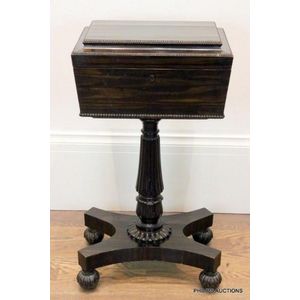19th Century Anglo-Indian Ebony Veneer Teapoy in William IV Style
An Anglo-Indian ebony veneer teapoy, 19th century the William IV style sarcophagus form teapoy with beaded rims, raised on a carved column and quadripartite platform ending in fluted bun feet, the interior adapted as a work box. Height 29.92 in., width 16.54 in., depth 12.60 in.
You must be a subscriber, and be logged in to view price and dealer details.
Register Now to view actual auction price for this item.
- Ebony - Ebony is a close grained timber, black in colour. It has a fine texture which can be polished to a high gloss, making it suitable for venereering, inlay and stringing and its use as solid timber is resticted to small decorative items and ornamental decoration, such as chess pieces and musical instrument parts. The term "ebonised" means "faux ebony", timber that has been darkened during the polishing process to resemble ebony.
- William Iv - William IV was King of the United Kingdom and King of Hanover from 26 June 1830 until his death in 1837, and in English furniture design it represented the brief period between the end of the Regency period, and the beginning of the Victorian period.
This item has been included into following indexes:
